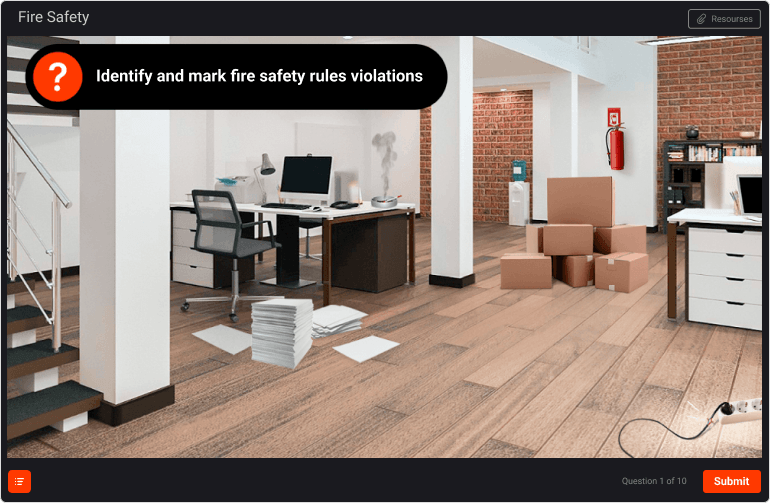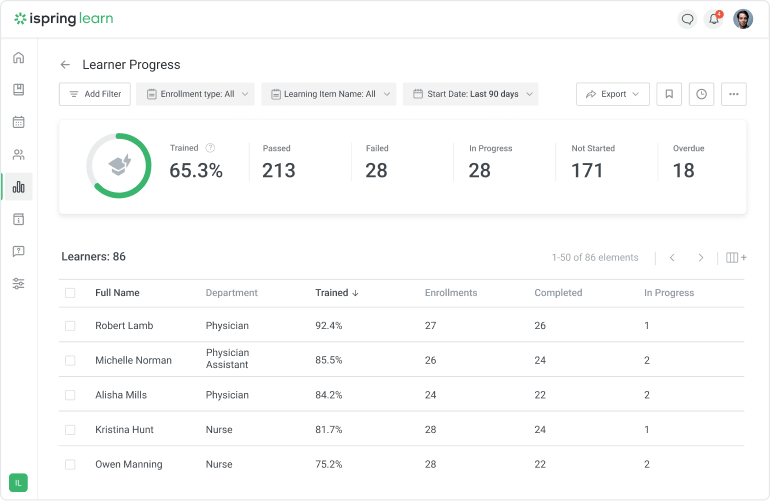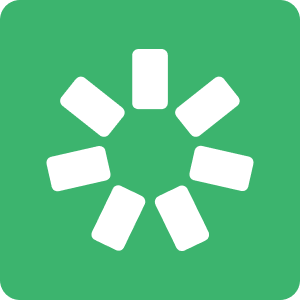Revolutionizing Employee Training In Healthcare Organizations
Corporate training is a business imperative, and it makes sense. The issue is how to get employees excited about training. Is there any secret way to turn your employees into training enthusiasts? We know of a few. This article will break down what should be considered when training healthcare staff and how to make it more effective.
Creating An Easily Accessible Learning Environment
Gone are the days when companies could get all their staff in a room for hours-long training. Today, employees are looking for flexibility—they want to learn when and where it’s convenient for them, and in digestible “chunks” that fit into their workflows. So, training programs, formats, and delivery must be aligned with this.
The only solution that will help you address the issue of flexibility is online training, and this is where a Learning Management System (LMS) comes in handy. A healthcare LMS, like iSpring Learn, will be your entire company knowledge base that will keep all learning materials under one roof and provide access to them for your employees 24/7. For example, you can record a video on how to communicate with patients and upload it to the platform so your employees can view it when it fits into their schedules.
If you need your personnel to undergo compliance training that is typically mandatory and time-sensitive, you can assign courses to employees and set the timeframes within which they have to complete training.
With an LMS, your staff can take courses on any device—desktop, laptop, tablet, or smartphone. The most advanced platforms come with native iOS and Android mobile apps that allow employees to learn even when offline, on their way home, for example. The moment they’re back online, the LMS will show trainers how many courses employees completed and how well they did.
Developing An Effective Onboarding Process
Onboarding is the most important time period in the employee life cycle at a healthcare company. The quality of onboarding affects that which matters most in any business: staff retention, employee productivity, and overall company performance.
There’s also a legal side to onboarding in healthcare organizations that’s just as important. The healthcare industry is subject to many strict standards and regulations, and non-compliance can lead to fines and other repercussions. Thorough compliance training at the entry level is the best way to ensure that all standards are met.
When structuring onboarding, there are several key aspects that need to be considered. The onboarding process should:
- Be relevant to all the staff but adaptable to employee roles
- Make new hires feel welcome and appreciated
- Provide newcomers with job-specific knowledge that will help them succeed in their role
To set onboarding up for success, you need to create a solid training plan that will lay out a schedule, objectives that you set for a new hire, tasks they need to accomplish within a certain timeframe, and responsible parties. Once it’s ready, you can pack all the necessary information into online courses and upload them to the LMS.
Training platforms like iSpring Learn allow you to create structured training programs (learning tracks) by combining a series of courses. The best part is that you can control the order in which courses should be taken and the timeframes within which they are available.
But the main benefit you receive by using the LMS is the complete automation of the onboarding process. You just need to create a training program once and assign it to all your new personnel. The platform will automatically enroll employees in courses, send reminders to keep them on track, and generate reports on learner progress and results.
Building Training Content That Actually Works
Studying dozens of Word pages with federal and state regulations is real torture, even for those who realize its importance for their work. But the reality is that even compliance courses can be engaging if you know how to spice them up.
Here are 3 proven practices that will make your content work.
1. Add Interactivity To Your Courses
Interactivity encourages some kind of “dialogue” between a learner and a course. This makes learners actively involved in the entire online learning process and increases their level of engagement. So, instead of offering a fire safety manual PDF to your staff, immerse them in an interactive game-based course.
2. Devise An Unconventional Approach
Another way to make eLearning in the healthcare industry engaging is to be creative in the way you produce content. For example, if you need to train your employees on communication with patients, you can provide them with a checklist of essential dos and don’ts. Or you can take a more creative path and develop a role-play simulation in which employees need to make decisions—not just read about them. And these decisions lead to specific consequences. Employees can see why they should be polite with patients and listen to what they’re saying attentively.
3. Provide Knowledge Checks
And last but not least, nothing motivates someone to learn like knowing that your knowledge will be assessed. So, make sure to incorporate graded quizzes in your online courses. They will help your employees reinforce their knowledge and let you stay on top of their level of performance.
Collecting And Analyzing Learning Data
Gathering data on different training metrics, like course completion, time spent learning, and user engagement, is essential for any healthcare organization. Coming back to mandatory compliance training, reports with training results are proof that employees have completed the program.
Besides, training analytics can provide you with many insights that you would not be able to acquire elsewhere. For example, you can see how well your employees understood the information and who is ready to work with patients, or find shortcomings in the content and decide how it needs to be improved.
Modern LMSs, like iSpring Learn, have a powerful reporting engine. They provide a broad set of reports that enable you to monitor almost any metric, from learner progress and results to learner account logins and a comprehensive enrollment history.
You can export reports to Excel spreadsheets and email them to supervisors or other bodies, or automatically transfer data to HRIS, CRM, and other platforms if you have a specific LMS integration.
Preparing For The Future
Today, online training is the only way for healthcare companies to keep their employees skilled and up to speed. By focusing on aspects like creating an easily accessible learning environment, providing strong onboarding, building engaging content, and introducing in-depth training analytics, HR managers and L&D professionals can offer more effective training to their staff.






